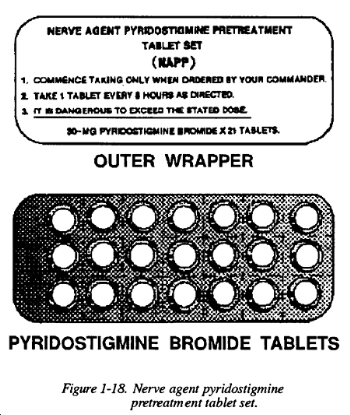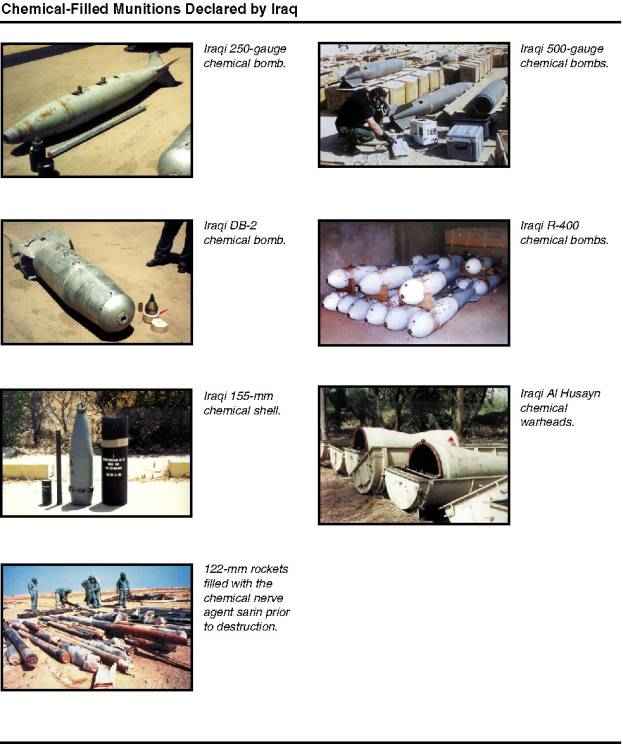|
Nerve Agents If you wonder why everyone is so concerned about terrorists getting chemical weapons, there's a simple answer. They're just plain nasty business, and nerve agents are the worst of the lot.
If you wonder why everyone is so concerned about terrorists getting chemical weapons, there's a simple answer. They're just plain nasty business, and nerve agents are the worst of the lot. They enter the body through the skin or the lungs. A low dose is more or less like any other kind of poisoning. Symptoms include drooling, runny nose, tightness of the chest, dilated pupils, headaches, tiredness, slurred speech, hallucinations and nausea. The fun really begins in the medium to high dosages. In addition to some or all of the above, in much more severe forms, nerve agents can cause victims to experience "bronchoconstriction and secretion of mucous in the respiratory system." In other words, you can drown in your own mucous, if you don't cough your guts out first. After that, the cramps and vomiting start, following by full-body convulsions. If you're lucky enough to get a face full of nerve agent, you'll likely piss and shit your pants, while drooling uncontrollably, oozing from the eyes and breaking out in a sweat. At the highest exposures, the convulsions shift into high gear and if you're really lucky, you'll lose consciousness. Most of your muscles will become paralyzed, as in a nightmare. Your lungs are muscles, so you'll die from suffocation, unable to will your body to draw a simple breath. Nice, huh? History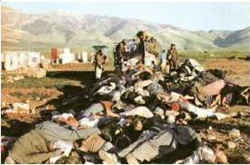 Not surprisingly, we have the Third Reich to thank for the modern nerve agent. In the 1930s, German scientists first noticed that nasty phosphorous based chemicals could be used to cause entertaining levels of pain and death.
Not surprisingly, we have the Third Reich to thank for the modern nerve agent. In the 1930s, German scientists first noticed that nasty phosphorous based chemicals could be used to cause entertaining levels of pain and death. A chemist with I. G. Farben developing a pesticide came up with a nasty phosphorous compound called tabun in 1934, the first official nerve agent. In the years leading up to World War II, the research continued at a fever pitch. The Nazis produced 12,000 tons of tabun between 1942 and 1945, but never got around to using them. By the end of the war, German science had developed a couple thousand variations on the compound, including the best-known nerve agent, sarin, but they only managed to manufacture several hundred pounds before the Allies pounded their asses into the dust. The noble Allies responded to the discovery of massive CW stockpiles by immediately launching research into antidotes and preventive measures, only "accidentally" discovering new and better nerve agents along the way.
Chemical StatesSo who has chemical weapons? Who should you be worried about?Perhaps the most obvious purveyor of these internationally banned weapons is (of course) the United States. According to the Federation of American Scientists, the U.S. has massive stockpiles of chemical weapons and related delivery systems. The U.S. chemical arsenal includes Mustard Gas, and the nerve agents VX and GB. About 40% of this stockpile is locked and loaded and ready to go, although some of it is considered obsolete, according to FAS. And here's a fun little bit of trivia although the U.S. is a participant in the U.N. Chemical Weapons Conventions, there's no domestic law prohibiting their use. Policy dictates that chemical weapons not be used in a first strike, but the president is authorized to order their deployment, under the same kind of command-and-control structure that applies to nuclear weapons use.
The U.S. is also alleged to have used nerve gas during the Vietnam War, but there is some controversy around those reports. Obviously, Iraq was one of the primary suspects in the chemical weapons game. In fact, U.S. officials were so concerned about Saddam Hussein's chemical weapons program that they used it as the pretext to invade the country. On paper, it seemed like a reasonable suspicion, but as of this writing, the successful U.S. invasion force has yet to find any chemical weapons of note in Iraq. However, Iraq is strongly suspected of having employed nerve agents against U.S. troops during the first Gulf War; Hussein also used mustard gas against Iran and in a genocidal attack on the Kurds in Northern Iraq. It is widely believed that nerve agents were used in both these offensives. The details are subject to some debate, but it's widely suspected Iraqi forces used sarin gas in both these instances. Many of the supplies used in Iraq's past chemical weapons programs came from the United States, which supported Hussein during the Iran-Iraq war with assistance developing various chemical and Biological Weapons. The British built a chemical weapons plant for the Iraqis in 1985, which was probably used to manufacture sarin (the plant later featured in documents presented by the U.S. to justify the 2003 invasion).
Much talked about as the next potential U.S. conquest in the Middle East, the State Department alleges that Syria is trying to develop rocket-powered delivery systems that could be used for chemical weapons delivery, with the help of North Korea and Russia. Many of Iraq's now unemployed chemical weapons scientists are thought to be seeking jobs in Syria or Libya, or with Osama bin Laden's al Qaeda network.
DeploymentOn the bright side, nerve agents are difficult to effectively deploy, which is the major reason they haven't been widely used to date.al Qaeda allegedly experimented with the use of chemical weapons, but found them too difficult to use safely. Intelligence gathered during the invasion of Afghanistan revealed that the terrorist network had experiemented with nerve agents on animals in training camps.
Nerve agents mostly come in gas or liquid forms. They can be released through the use of pressurized containers or sprayers, or attached to bombs (a more complicated process). Because they tend to be highly volatile compounds, they quickly disperse in open air, which can result in only minimal dosages to the intended victims. They can also be deployed on rockets for long-distance and battlefield uses, but again, the effectiveness of this technique is somewhat debatable. There is a theory that this sort of attack was used on U.S. troops during the first Gulf War, which has been proposed as a possible explanation for the mysterious illness suffered by veterans of the conflict, known as Gulf War Syndrome. Because of these limitations, nerve agents are generally more lethal when used in closed spaces. The most effective use of a nerve agent for terrorism was the Tokyo Subway attack of 1995. Containers of sarin gas were placed on trains running through the subway system, all of which passed through a central station, resulting in exposures both on the trains and on the platforms. Nearly 6,000 people were exposed to the gas. Even with the relatively enclosed spaces, only 12 people died, and a few hundred hospitalized. The helpful and not-at-all-scary Department of Homeland Security is right on top of the threat from nerve agents. It advises American citizens to be on the lookout for subtle warning signs, such as "many people suffering from watery eyes, twitching, choking, having trouble breathing or losing coordination" or "many sick or dead birds, fish or small animals."
In the event that you notice people and animals dying by the dozen all around you, don't panic! The DHS gurus suggest the following preventive measures:
If you feel you've been exposed to a nerve agent, and you're not busy shitting yourself, convulsing and drowning in your own mucous, consider the following useful tactics, also courtesy of the DHS:
|
 Good old U.S. know-how dramatically upped the effectiveness of nerve agents such as sarin, making them ten times as toxic and creating gaseous and volatile versions which could be quickly dispersed over large areas. Not wanting to miss out, the British developed VX in 1949, the last great nerve agent and considered the most toxic of all.
Good old U.S. know-how dramatically upped the effectiveness of nerve agents such as sarin, making them ten times as toxic and creating gaseous and volatile versions which could be quickly dispersed over large areas. Not wanting to miss out, the British developed VX in 1949, the last great nerve agent and considered the most toxic of all. The U.S. is, of course, a great source on the glass houses of other countries vis a vis chemical weapons. According to the State Department, the largest current chemical weapons programs are found in the hands of a fairly predictable group of players.
The U.S. is, of course, a great source on the glass houses of other countries vis a vis chemical weapons. According to the State Department, the largest current chemical weapons programs are found in the hands of a fairly predictable group of players.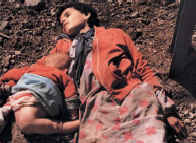
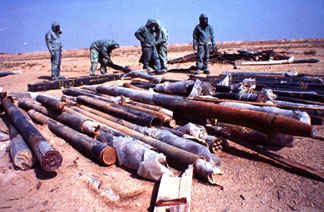 Anecdotal stories about attempts to train terrorist hopefuls in their use indicated that, as often as not, the operatives managed to poison themselves. One story described a failed experiment which ended with the mercy killing of a young operative who accidentally exposed himself to the toxin, incurring gruesome results.
Anecdotal stories about attempts to train terrorist hopefuls in their use indicated that, as often as not, the operatives managed to poison themselves. One story described a failed experiment which ended with the mercy killing of a young operative who accidentally exposed himself to the toxin, incurring gruesome results.